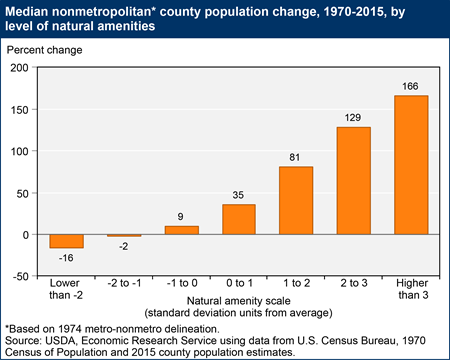"Natural Amenities" is
based on the premise that people are drawn to areas with varied topography; lakes, ponds, or oceanfront; warm, sunny winters; and temperate, low-humidity summers.
It's a composite score averaging six other highly desired geographic and environmental features.
The two that need explaining are the "varied topography" and "temperate summers":
- Varied topography means that there is a high mix of flat land, hills, and mountains. Most people prefer having some hills or mountains in their vicinity, which gives an unbuildable natural scenery available for recreation, as opposed to sprawling plains like Kansas that seem to induce uniformity and an inability to change scenery.
- Temperature summers defined here doesn't mean "not hot," though it often does. It's about having less temperature gain from winter (January) to summer (July).
What I really find interesting about this Natural Amenities scale is that it is highly correlated to almost all population growth for the last 5 decades in the rural US! (urban areas probably deviate more because of economic network effects)

It also correlates to lower obesity. That might be because people in these areas have multiple more reasons to be outside and active in physical recreation.
So if you're looking for a place with nature, nice weather, and even being physically healthy with future population growth and rising housing values, the natural amenities feature is an important one to value highly.
However, these likely also correlate to higher home prices, and if these aren't important to you, going for a low natural amenities score may give you a better deal on housing.
To find places like this, go to the ExoRoad filtering tool at ExoRoad, open the Activities filters on the sidebar, and play with the slider.